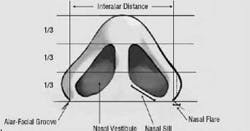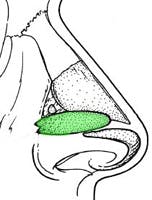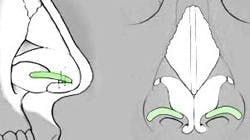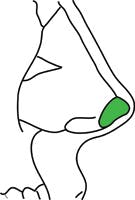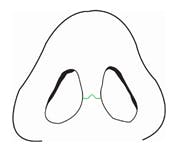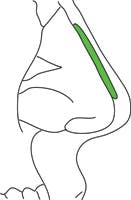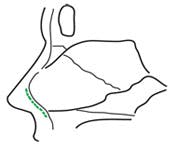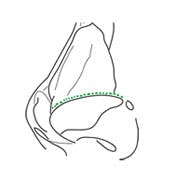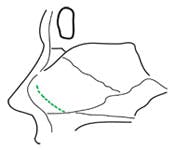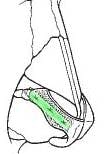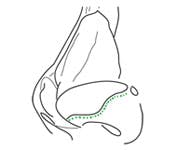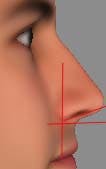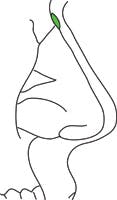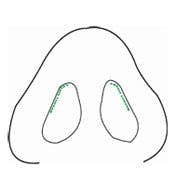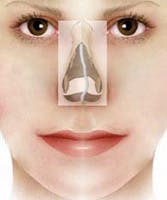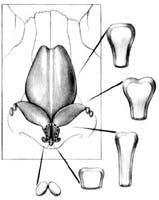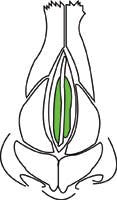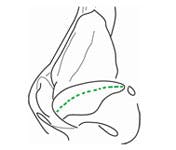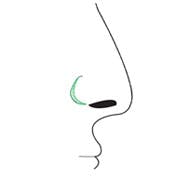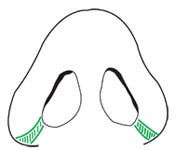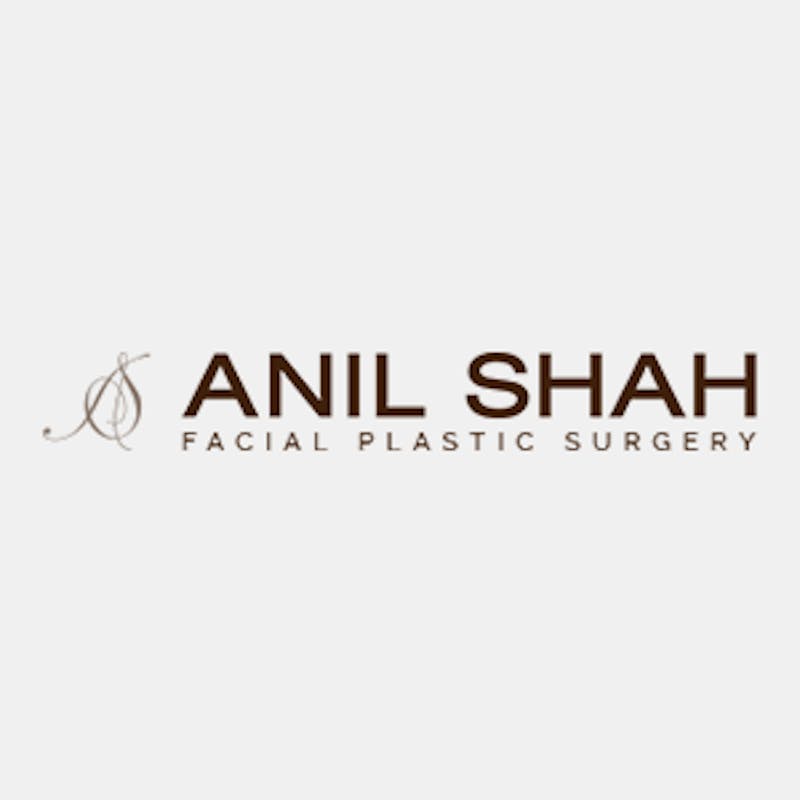
Posted by Dr. Anil R. Shah

Here you will find commonly used termonalogy in regards to rhinoplasty. Where a ![]() is seen, more infomation on that particular term can be found else where on the site. To hear a pronunciation of each term, play audio by each definition.
is seen, more infomation on that particular term can be found else where on the site. To hear a pronunciation of each term, play audio by each definition.
A | B | C | D | E | F | G | H | I | J | K | L | M | N | O | P | Q | R | S | T | U | V | W | X | Y | Z
Accessory cartilages – ak-‘ses-(ə-)rē ‘kärt-əl-iji-es
Small cartilages lateral to the lateral crus. Historically these cartilages were thought to provide a minor contribution to tip support. The accessory cartilages may contribute to support of the external nasal valve. They are not typically seen clinically.
Adenoid – ad’ ə-noid
Lymphoid tissue located in the posterior of the nose. Adenoids can cause nasal obstruction when abnormally large. Diagnosis of large adenoids requires nasal endoscopy or a mirror exam. Adenoid tissue typically regresses in adults and may be a sign of allergy, reflux changes or HIV.
Makes up a portion of the lower one third of the nose and corresponds to the underlying lower lateral cartilage.
The base of the nostril and how it inserts and relates to the face. This is a suprisingly complex structure with width and shape which can be altered by surgery.
Alar Batten graft – a’lar bat-?n graft ![]()
A structural graft used to support the external valve. More information can be found here.
Alar cartilage – a’lar ‘kärt-əl-iji
Also known as lower lateral cartilages, they are paired structures which have three portions, a lateral, intermediate, and medial portion.
A groove or depression which that follows the caudal margin of the lateral crus as it leaves the alar rim to run in a more cephalic direction. It separates the tip from the thickened portion of the ala that joins the face at the superior cheek-lip junction.
Alar retraction – a’lar ri-‘trak-shən
When the caudal aspect of the nostril rim is retracted superiorly, leading to excessive nostril show. Must be distinguished from excessive columellar show.
Alar Rim Graft – a’lar rim graft ![]()
A graft used to support the edge of the nostril. More information can be found here.
Anterior – an-en-tēr’e- ər
Front (Corresponds to the side of the body with the face).
Anterior nasal spine – an-‘tir-ē-ər nā-zəl spīn
a small portion of bone which can effect the columellar labial angle. Important clinically to distinguish from a prominent posterior septal angle, which is far more common. A prominent nasal spine can make the upper lip look short and tethered.
viewed from the bottom of the nose
Brow tip aesthetic line
a line created from the patient’s brow to the tip of the nose which should be smooth and unbroken. May be disrupted by asymmetry or nasal deviation.
the portion of the nose that is supported by the nasal bones.
a rare disorder characterized by underdeveloped midface, a short nose and flat nasal bridge, and protrusion of the mandible (jaw). Many patients will have difficulty breathing, snoring, with speech, and cosmetically.
Canthal – kan’thə
of, or having to do with the corner of the eyes
Cartilage splitting (intra-cartilagenous) incision – kärt-əl-iji split-iŋ in-‘sizh-ən ![]()
a type of endonasal rhinoplasty maneuver in which the excess cephalic cartilage (top portion of cartilage) is removed while the rest of the cartilage remains intact. The advantages of this approach is that there is less disruption of remaining tissues, minimal swelling occurs postoperatively, and no grafts or internal sutures are required. The disadvantages of this approach is it may be difficult visualization for surgeons with limited endonasal rhinoplasty training and not all noses are candidates for this type of surgery.
Cartilaginous pyramid – kahr”tĭ-laj’ĭ-nəs pir-ə-‘mid
the cartilage which sits on top of the septum and is joined by the upper lateral cartilages. Excessive removal of this structure without support may lead to an “inverted V deformity”.
Caudal septum – kaw’dəl sep-təm
the anterior (front) of the septum which is cartilaginous in nature. The caudal septum has three angle associated with it a anterior, middle and posterior septal angle.
Caudal – kaw-‘də
inferior or bottom (towards feet)
Caudal extension graft – kaw’dəl ik-‘sten-chən ![]()
graft a cartilaginous graft used to extend the septum and place the tip in a more favorable position. The graft is suprisingly versatile and can be used for a wide variety of purposes in rhinoplasty. Most commonly used in external rhinoplasty.
Cephalic – sə-‘fal-ik
means same as superior when referring to the nose; directed toward or situated on or in or near the head
Closed rhinoplasty – klōzd rī-nō-‘plas-tē
see endonasal rhinoplasty
the column at the base of the nose of soft tissue which separates the nostrils (or columna). The incision for external rhinoplasty takes place here.
an incision made along the columella in an external rhinoplasty approach. The columellar incision is typically made midway between the nostril and base of the columella. It can be a variety of shapes, most commonly using the inverted V incision or a stairstep incision. More info
Columellar labial angle – käl-(y)ə-‘mel-ər lā-bē-əl aŋ-gəl ![]()
curved junction of the columella with the lip.
Columellar lobular angle – käl-(y)ə-‘mel-ər läb-yə-lər aŋ-gəl
the angle formed by the junction of the infra-tip lobule with the columella.
Columellar show – käl-(y)ə-‘mel-ər shō
the amount of columella seen on lateral and frontal view.
Collumellar strut – kkäl-(y)ə-‘mel-ər
a cartilage graft which is placed between the medial crus to provide tip support Not all columellar struts are the same size. Extended columellar strut is a variant used for cases of profound lack of tip support and columellar spacer may be used to prevent an overly narrow columella.
Concave – kän-‘kāv
hollowed or rounded inward (i.e. inside of a satellite dish)
Convex – kän-‘veks
curved or rounded out (outside of a ball)
Crooked nose – nōz ![]()
deviation of the external portion of the nose which can be a result of bony or cartilaginous deformity.
Crus – krüs
Generic reference to the lower lateral cartilage. can refer to medial, lateral or intermediate portion of the cartilage.
Dorsal – dor- sə
where the lateral surfaces of the upper 2/3 of the nose join in the midline. Sometimes referred to as the dorsum nasi
Delivery approach – di-‘liv-(ə-)rē ə-‘prōch
the lower lateral cartilages are accessed without a scar on the columella. The main benefits of this approach is that sutures can be placed and excessive cartilage can be excised. More advanced cartilage manipulations may be difficult in some cases.
Dorsal Augmentation Graft – d?r-s?l ?g-m?n-‘tā-sh?n ![]()
graft Graft placed on bridge of septum.
Epistaxis – ep-ə-‘stak-səs nose bleed
Endonasal rhinoplasty – rī-nō-‘plas-tē aka
Closed Rhinoplasty Rhinoplasty performed without an incision on the columella.
Extended Columellar Strut – extended käl-(y)?-‘mel-?
strut A large graft used in a supportive fashion to improve tip support more information can be found here.
External nasal valve – ek-‘stərn-əl nā-zəl
valv external opening of the nostril.
External rhinoplasty – ek-‘stərn-əl rī-nō-‘plas-tē
Aka Open Rhinoplasty. A form of rhinoplasty where an incision is made on the columella to gain better visualization and access to placement of cartilage grafts.
as viewed from the front
Frontal process – frənt-əl präs-‘es
a long plate that is part of the maxillary bone and contributes to the formation of the lateral part of the nose and of the nasal cavity — called also nasal process
Frontonasal
The frontal bone of the nose
Full transfixion incision – full tran(t)s-‘fik-shən in-‘sizh-ən
an incision in front of the septum through both sides. May be more destabilizing than a hemi-transfixion incison or Kilian incision.
(Latin for “hairless”) the area in between the brows right directly above where the root of the nose touches the forehead; the smooth prominence between the eyebrows
Hemitransfixion incision – trans-fiks in-‘sizh-ən ![]()
an approach to the septum where the incision is made in the membranous septum, which is anterior the cartilaginous portion of the septum. The incision does is through one side of the membranous septum. More info
Inferior – in-‘fir-ē-ər
bottom
the portion of the lobule between the tip defining points and the columella
Inter-cartilaginous incision – kahr”tĭ-laj’ĭ-nəs in-‘sizh-ən ![]()
An incision placed just on the lower lateral cartilage side of the junction of the upper lateral cartilage with the lateral crus of the lower lateral cartilage. It can be used to access the nasal dorsum or combined with a marginal incision to deliver the lower lateral cartilages. More info
Internal nasal valve – in-‘tərn-əl nā-zəl
valv the area of the junction of the caudal edge of the upper lateral cartilage with the nasal septum which is the narrowest portion of the nasal airway in a normal nose.
Inverted V deformity – in-vurt-d V di-‘f’r-mət-ē
when the middle portion of the nose is pinched and the nasal bones can be seen outlined (looks like an inverted V deformity). Thinner skinned patients, short nasal bones, large nasal humps are all conditions which predispose to this postoperative complication. Aside from cosmetic deformation, these patients may have collapse of their upper lateral cartilages leading to nasal obstruction.
Triamcinolone acetonide, is a type of steroid. It the most commonly used type of steroid for post rhinoplasty injections. Injections are used primarily in the supratip of the nose to help decrease the amount of swelling and reduce the amount of scar tissue formed here.
Keystone area
junction of the perpendicular plate of the ethmoid with the septal cartilage at the dorsum of the nose. If this structure is disrupted, total nasal collapse may result necessitating complex reconstruction of the nose.
an approach to the nasal septum where an incision is made 1 to 2 cm posterior (behind) the caudal edge of the cartilaginous septum. It is considered to be less disruptive to the nasal tip support mechanisms. More info
of or relating to the side
as viewed from the side
Lobule – äb-(‘)yü(ə)l
the lower part of the nose, aka the nasal tip.
Lower lateral cartilages (LLC) – loh-er lat-ə-rəl ‘kärt-əl-iji-es ![]()
the paired inferior nasal cartilages consisting of the medial, middle, and lateral crura.
Marginal incision – märj-nəl in-‘sizh-ən ![]()
an incision on the inferior surface of the lower lateral cartilages. It is used in both delivery rhinoplasty and external rhinoplasty. More info
Medial – mēd-ē-əl
being or occurring in the middle
Menton – men-‘tän
the chin
Nasal bone – nā-zəl bōn
the bony portion of the upper one third of the nose which lies inferior to the frontal bones and anterior the maxilla. Suprisingly small and weak in size, the nasal bones fracture quite commonly.
Nasal length – nā-zəl leŋ(k)th
the distance from the top of your nose to the nasal tip. (from radix to tip) Must be distinguished from projection.
Nasal lobule – nā-zəl läb-(‘)yü(ə)l
the lower part of the nose bounded by the anterior nostril edge postero-inferiorly, the supratip area superiorly and the alar grooves laterally.
Nasal obstruction – nā-zəl əb-‘strək-shən ![]()
restriction of airflow through the nose with normal breathing
Nasociliary nerve – na’zo-sil-ē-‘er-ē nərv
a branch of the ophthalmic nerve distributed in part to the ciliary ganglion and in part to the mucous membrane and skin of the nose –called also nasal nerve
Nasofrontal angle – na’zo-frənt-əl aŋ-gəl
angle of demarcation between forehead and nasal dorsum
Nasolabial angle – fbna’zo-lā-bē-əl aŋ-gəl ![]()
the angle seen on lateral view formed by a line drawn through the most anterior to most posterior point of the nostril intersecting the vertical facial plane.
Nasopalatine nerve – na’zo-‘pal-ə-‘tīn nərva
parasympathetic and sensory nerve that arises in the sphenopalatine ganglion, passes through the sphenopalatine foramen, across the roof of the nasal cavity to the nasal septum, and obliquely downward to and through the incisive canal, and innervates esp. the glands and mucosa of the nasal septum and the anterior part of the hard palate
Nasopharnyx – na’zo-‘far-iŋ(k)s
the upper part of the pharynx continuous with the nasal passages
Oblique – ō-‘blēk
As viewed from an angle, typically 45 degrees
graft Graft used to camouflage areas of the nose link to here.
Open roof – ō-pən rüf
when a large bony nasal hump is removed, there may exist a large gap betwen the nasal bones and the bony septum. Osteotomies may help break the bones and close the roof.
Osteotomies – äs-tē-‘ät-ə-mē
the breaking of nasal bones, and sometimes maxilla, with a specially designed chisel, to reshape the nasal pyramid.
Pinched tip –
Refers to the tip being too thin which can occur from improper technique and even nasal valve collapse due to lack of cartilaginous support or removal of scar tissue if revisionary.
Pollybeak deformity – di-‘f’r-mət-ē
a nasal deformity caused by the supratip becoming the leading portion of the nose rather than the nasal tip. This can occur from excessive soft tissue (typically the surgeon lost too much nasal projection) or excess nasal cartilage (the surgeon failed to remove enough cartilage in profile alignment)
Posterior – pō-‘stir-ē-ər
behind
Projection – prə-‘jek-shən ![]()
![]()
the measure of how far your nose sticks out from your face.
when the nasal tip hangs inferiorly creating an acute nasolabial angle. The ptotic nasal tip may be associated with old age, genetic predispositon, or as a result of surgery or trauma. Some patients notice improved nasal breathing when the tip is raised.
Pyramid (nasal) – pir-ə-‘mid (1)
Bony pyramid: The bony portion of the nose made up bilaterally of the nasal bone and frontal process of the maxilla.; Cartilaginous pyramid: the cartilage which sits on top of the bony pyramid.
Premaxilla – prē-mak-tsil-ə
the superior (top) portion of the upper lip which borders the nose. A depressed premaxilla can be a result of overaggressive primary surgery, congenital deformation (i.e. Binder’s syndrome), or even dental abnormality.
Pyriform apeture – ap-er-cher
the pear-shaped external bony opening of the nasal cavity. called also – piriform, piriformis
Radix – rād-iks
areas of junction between the frontal bone and the dorsum of the nose.
graft graft used to increase height at radix or top of nose link.
Rasp – rahsp
a specially designed instrument which helps reduce reshape the bony prominence of the nose.
A rhinoplasty to correct a previous rhinoplasty
reshape the nose for functional or cosmetic purposes
Rim incision – rim in-‘sizh-ən ![]()
an incision placed just within the vestibular edge of the rim of the nares. No real indication for this incision in cosmetic rhinoplasty. More info
Rocker deformity – rok-er di-‘f’r-mət-ē
when the osteotomy is placed too far superiorly (high) onto the frontal bones, the nasal bones will not be able to be mobilized effectively.
Root (nasal) – rüt
there the nose joins the forehead.
A nose marked by depression of the bridge of the nose (hence the nose has a dip in the middle, similar to a saddle). It is important to distinguish whether the saddle is a result of cartilage or bony depresion. A wide variety of disease processes can cause a saddle nose deformity.
Sroll area
The area of recurvature of the lateral crus of the lower lateral cartilage at its junction with the upper lateral cartilage.
septal deviation – sep-təl dē-vē-‘ā-shən ![]()
when a portion of the cartilage or bony septum protrudes into the nasal airway causing obstruction.
Septoplasty – sep-tə-‘plas-tē ![]()
surgical repair of the nasal septum
Septorhino
The surgical repair of the nasal septum with added cosmetic techniques as well
the bony and cartilaginous partition between the nasal passages “Divides the nasal passage into two cavities. It consists of a bony (perpendicular plate of ethmoid, vomer and premaxillary crest), cartilaginous (quadrilateral) and membranous portion.”
Sesamoid cartilages – ses-ə-‘m’id ‘kärt-əl-iji-es
Small cartilages found in the lateral space between the upper and lower lateral cartilages. (lesser alar cartlages)
A graft used to provide projection and shape to the nasal tip lobule. More information can be found here.
Short nose – short nōz
when the nose is short or upturned on lateral view. Patients may complain about excessive nostril show on the frontal view.
Soft tissue triangle – soft tish-(‘)ü trī-‘aŋ-gəl
the thin skin fold between the alar rim and the curved caudal border of the junction of the medial and lateral crura. When this is well defined it is referred to as a facet.
Spreader grafts – spred-er graft ![]()
a long wedge of cartilage placed between the septuma and the upper lateral cartilage to open the internal nasal valve. The graft can also be used after dorsal hump removal to prevent an “inverted V deformity” and improve the brow tip aesthetic line.
Superior – su’-‘pir-ē-ər
Top.
The area just superior to the nasal tip at the inferior aspect of the nasal dorsum.
tip Apex of the lobule, but it is frequently used when referring to the lobule.
Transfixion incision – tran(t)s-‘fik-shən ![]()
an approach to the septum where the incision is made through both sides of the membranous septum. More info
Turbinates – tər-bə-nət, -‘nāt ![]()
structures which normally humidify the air you breathe, but can become pathologically enlarged with allery or irritation.
Upper lateral cartilages (ULC) – ‘əp-ər lat-ə-rəl ‘kärt-əl-iji-es
the paired superior nasal cartilages, triangular in shape extending laterally from the dorsal septum making up the lateral walls of the middle third of the nose.
Vomer – vō-mər
a bone of the skull that in humans forms the posterior and inferior part of the nasal septum comprising a vertical plate pointed in front and expanding at the upper back part into lateral wings
Vibrissa (plural: vibrissae) – vī-‘bris-ə
any of the stiff hairs growing within the nostrils that serve to impede the inhalation of foreign substances
An incision which is used to narrow the base of the nostrils. It is most often refers to all incisions which narrow the alar base. More info
An incision which is used to narrow the base of the nostrils. It is most often refers to all incisions which narrow the alar base. More info
- Anatomy
- Glossary
- Male Rhinoplasty
- Revision Rhinoplasty
- Auricular Cartilage Grafting in Rhinoplasty
- Costal Cartilage Grafting in Rhinoplasty
- Nasal Obstruction
- Septoplasty
- Open Versus Closed Rhinoplasty
- Alar Retraction
- Crooked Nose Deformity
- Augmentation Rhinoplasty
- What’s New
- Videos
- Pre and Postop Instructions
“The nose should fit the face”
A strong jawline would suggest a stronger nose.

